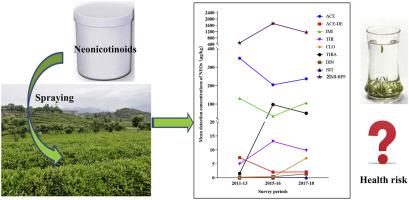Environmental Pollution ( IF 7.6 ) Pub Date : 2020-06-29 , DOI: 10.1016/j.envpol.2020.115119 Shaohua Li 1 , Jun Ren 2 , Lifeng Li 3 , Rongbing Chen 4 , Jingguang Li 5 , Yunfeng Zhao 5 , Dawei Chen 5 , Yongning Wu 5

|
The extensive use of neonicotinoids (NEOs) has caused the release of wide-ranging of residues to the environment and food, and their potential health risks are now receiving more attention. In this study, three surveys were conducted to obtain the overall profiles of NEO residue levels (seven NEOs and one metabolite) in Chinese tea over a period of seven years. A total of 726 tea samples were tested, and nearly 87% of the samples were found to have detectable NEO residues. The overall average detection frequency of acetamiprid was the highest, reaching 73%. Imidacloprid residues in 4.6% of the samples exceeded the Chinese maximum residue limits, whereas clothianidin and nitenpyram had been detected in Chinese tea samples since 2014. The applications of thiacloprid and thiamethoxam gradually increased, and some tea samples with high residue levels appeared in China. These findings signal the replacement of new and old varieties of NEOs in China. Both long- and short-term cumulative exposures to NEOs were calculated based on optimistic and pessimistic models recommended in the EFSA guidelines. In the three survey periods, the average total imidacloprid-equivalent concentrations were 484.63, 1713.36, and 1148.34 μg/kg, respectively. Combined with the refined point estimates and probabilistic models used in this study, the hazard quotients of NEO residues in tea for Chinese tea consumers were found to be low and within the bounds of safety.











































 京公网安备 11010802027423号
京公网安备 11010802027423号